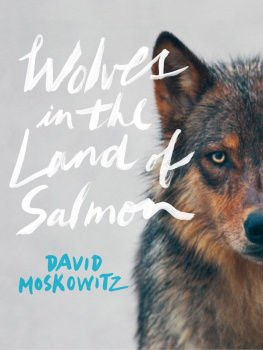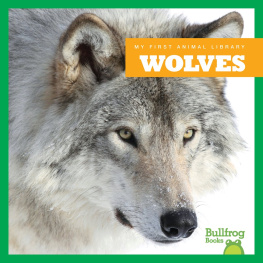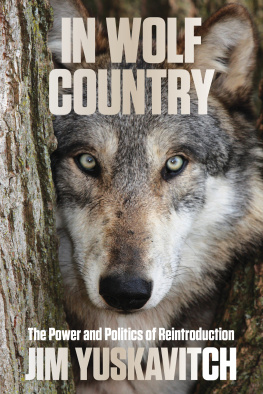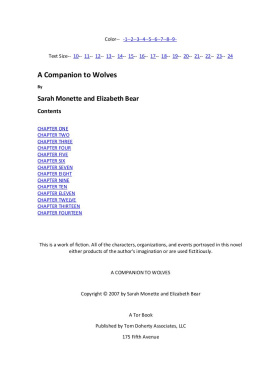
WOLVES IN THE LAND OF SALMON


FOR MY UNCLE LOUIS GOLDFARB,
FOR HIS RESTRAINED AND GENTLE MENTORSHIP
Frontispiece: A wolf crosses a lead of water along the shore of an island in Clayoquot Sound, British Columbia.
Copyright 2013 by David Moskowitz. All rights reserved.
All photographs by David Moskowitz except page 33 by Conservation Northwest and page 202 by the Oregon Department of Fish and Wildlife.
Illustrations on pages 5657 by Jenn Wolfe;
all other illustrations by David Moskowitz.
Maps created by Analisa Fenix / Ecotrust under a Creative
Commons license and prepared for publication by Laken Wright.
Published in 2013 by Timber Press, Inc.
The Haseltine Building
133 S.W. Second Avenue, Suite 450
Portland, Oregon 97204-3527
timberpress.com
2 The Quadrant
135 Salusbury Road
London NW6 6RJ
timberpress.co.uk
Printed in China
Book design by Laken Wright
Library of Congress Cataloging-in-Publication Data
Moskowitz, David, 1976
Wolves in the land of salmon / David Moskowitz.
p. cm.
Includes bibliographical references and index.
ISBN 978-1-60469-227-3
1. WolvesNorthwest, Pacific. 2. WolvesNorthwest, Pacific
Pictorial works. I. Title.
QL737.C22M676 2013
599.773dc23
2012025205
A catalog record for this book is also available from the British Library.

CONTENTS


MAPS
Wolves in the Pacific Northwest
A NORTHWEST WOLF CHRONOLOGY
1.8 to 2.5 million years ago | Wolves and coyotes depart from their shared ancestor, Canis leophagus , in North America; precursors to modern wolves migrate to Eurasia. |
800,000 to 300,000 years ago | Canis lupus emerges in Eurasia. |
130,000 to 100,000 years ago | Canis lupus migrates to North America from Eurasia. |
13,000 to 9000 years ago | Continental ice sheet retreats from the Pacific Northwest. |
14,000 to 8000 years ago | Pleistocene extinction event occurs at the end of the last period of glaciation; North America loses about half of its large mammal species. |
10,000 to 8000 years ago | Dire wolves ( Canis dirus ) becomes extinct, and Canis lupus emerges as the dominant large social carnivore across North America. |
early 1800s | First historical regional documentation of wolves eating salmon; a die-off of wolves in the Oregon Coast Range is attributed to a parasite which wolves contract from eating salmon. |
1821 | Hudsons Bay Company establishes fur trading posts in the Northwest. |
1843 | Bounties are placed on wolves in the Oregon Territory. |
1850 to 1900 | Wolves become scarce across most of Washington and Oregon. Populations of elk and many other carnivores and game animals decline similarly across the region. |
1909 | U.S. President Theodore Roosevelt creates Olympic National Monument to protect remaining Roosevelt elk; wolves are already scarce in the Olympic Peninsula. |
1910 | Oregon issues a moratorium on elk hunting; wolves are close to extinct in the state. |
1920 | Last confirmed wolf specimen is collected in Washington State from the western side of the Olympic Mountains, though reliable sightings in the Olympics are reported in the 1920s, 1930s, and even as late as the early 1950s. |
1930s | The last consistent reports of wolves in Oregon document them on the west slope of the Cascades. |
1933 | Following the rebound of elk populations, Oregon initiates a carefully regulated elk-hunting season. |
1938 | U.S. President Franklin Roosevelt expands Olympic National Monument into the current Olympic National Park. |
1946 | Last bounty for a wolf in Oregon is paid for an animal taken from Umpqua National Forest on the western slopes of the Cascades in southern Oregon. |
1950s to 1970s | Wolf populations in the Pacific Northwest probably hit their lowest levels and most contracted range. Wolves are functionally, if not completely, extinct from Oregon, Washington, Idaho, Montana, and southern portions of British Columbia. |
1960s | British Columbias wolf eradication programs destroyeither completely or nearly soVancouver Islands wolf population. |
1970s | Parvovirus is introduced into wild canids in North America from domestic dogs and is now endemic across the continent. Wolves begin reestablishing themselves in the southern portion of the Rockies in Canada following the abatement of control efforts in British Columbia and Alberta. |
1978 | Wolves are listed as an endangered species and receive federal protection across the lower forty-eight U.S. states under the Endangered Species Act. |
1986 | The North Fork of the Flathead River in northwestern Montana becomes the site of the first documented breeding pack to return to the northwestern United States, comprising wolves that had dispersed from over the border in the Canadian Rockies. |
1990 | Washington Department of Fish and Wildlife (WDFW) documents a pack of wolves with pups during a howling survey at the north end of Ross Lake, in North Cascades National Park. Though evidence of wolves here continues sporadically, further documentation of breeding wolves in the area is lacking for the next two decades. |
1995 and 1996 | U.S. Fish and Wildlife Service (USFWS) translocates wolves from the Canadian Rockies in Alberta and British Columbia to central Idaho and Yellowstone National Park. |
1999 | The first wolf to disperse to northeastern Oregon from Idaho is documented, a female who is captured and returned to Idaho. |
2000 to 2007 | Three more wolves from Idaho are found dead in northeastern Oregon, two of them shot. |
2006 | B300, a young female, is trapped and radio collared in western Idaho. |
2008 | WDFW traps and radio collars the breeding male and female of what became Washingtons first documented pack, the Lookout pack, on the east slope of the North Cascades in north-central Washington. |
2009 | Wolves are removed from the federal list of endangered species in the northern Rockies for the first time. Federal status as endangered continues in California and the western two-thirds of Washington and Oregon. |
Next page













